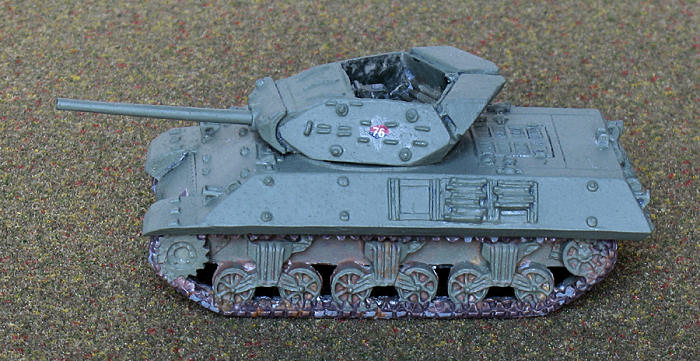
Battlefront 1/100 scale M10 Tank Destroyer
| KIT #: | US102 |
| PRICE: | £5.50 |
| DECALS: | none with the kit |
| REVIEWER: | Jeff Simpson |
| NOTES: | Resin and metal wargaming model |

| HISTORY |
I am sure the American M-10 has been seen, in other scales, on MM before, I have no doubt that Wikipedia would be a good place to search. The salient point is that the open-topped “tank destroyer” was a concept that did not work particularly well in action.
The Army: the
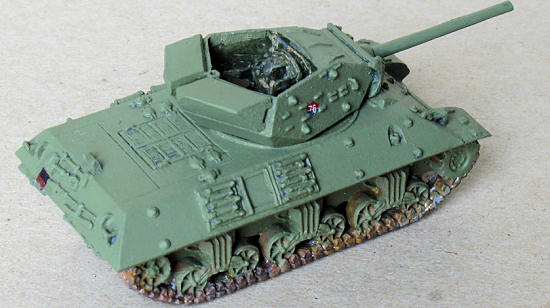 The New
Zealanders fought in
The New
Zealanders fought in
A little known
footnote to the end of the war in
Variants:
The M10 was
widely used by British and US Forces. There was an up-gunned version using the
17pdr gun and the
| THE KIT |
15mm or 1/100 scale is a common wargame scale and an enormous range of soldiers and equipment from Ancient History to the present day is represented in kit form from many different manufacturers. Most of these are metal cast “kits” with only a few parts, but there are also some resins. For a collector 1/100 scale is a reasonable compromise between detail and storage space requirements.
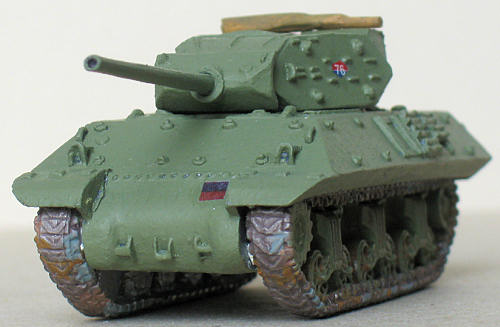 Battlefront are made in
Battlefront are made in
Three or four
years ago the kits were (and probably still are) widely available in
The single kit comes in a plastic blister pack, with the parts protected by a chunk of foam plastic. There are only a few parts: a resin hull and separate turret with mantlet, two white metal track units, gun barrel and machine gun.
I measured the hull at 61 mm long, which gives a scale of about 1: 97, which is within tolerance for a “15mm” kit. I did not measure other dimensions but the kit looks too tall to me and I filed the tracks and turret to reduce the overall height to look more reasonable.
| CONSTRUCTION |
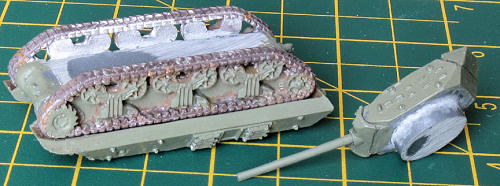 These models
do not usually require a lot of cleaning up: the resin is well cast with hardly
any flaws, ditto the metal parts. A little bit of filler is required, I used
white Milliput, which was smoothed with fine sandpaper when set. In the case of
the M10 the track units are quite a tight fit into the recess in the hull, I
filed the tops of tracks to get the correct sit of hull, whish I judged by eye.
These models
do not usually require a lot of cleaning up: the resin is well cast with hardly
any flaws, ditto the metal parts. A little bit of filler is required, I used
white Milliput, which was smoothed with fine sandpaper when set. In the case of
the M10 the track units are quite a tight fit into the recess in the hull, I
filed the tops of tracks to get the correct sit of hull, whish I judged by eye.
I filed the bottom of turret to reduce height slightly, again judged by eye.
The tracks and gun barrel were fixed with superglue.
Instead of using the provided machine gun I made up a shape out of plasticard and cast it in plaster, this was then carved to look like a canvas wrapped gun.
| COLORS & MARKINGS |
The lower hull and tracks and suspension were painted a mixture of browns to try to give a rusty/ dirty/ used look.
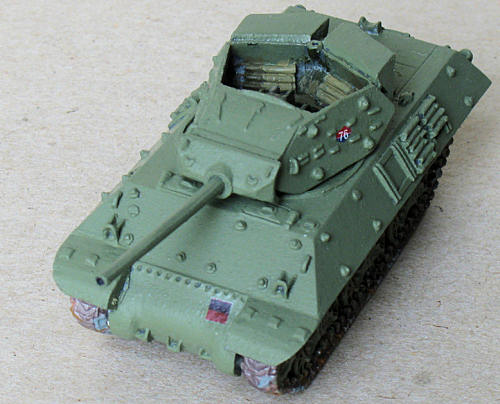
By the late war period, the New Zealand Army colours were overall green. I assume it would have been similar to British Army green. I mixed up what looked to me to be a reasonable sort of green, using Testors Matt Medium Green acrylic as a starting point, with a dash or two of brown. No doubt there are experts around who could advise on the exact colour mix details, if the paint was actually mixed to specification. This was thinned and brush applied to the upper hull, turret and the outer parts of the suspension. The interior of the turret was painted a darker shade, with seats and ammunition details picked out in a browner shade.
I painted on small patches of gloss varnish front and rear and on the turret sides. After that had dried I applied decals: square divisional markings and a diamond shaped tactical marking on the turret sides. The decals were obtained from “command decision” who market a range of “15mm” and other wargame scale decals. I overpainted the decals with matt varnish.
The wrapped machine gun was painted brown and then a wash of green was applied to give a faded canvas look.
| CONCLUSIONS |
The kit is nicely detailed and is a fairly quick build, requiring a little bit of modelling skill and judgement to make it “look right”.
| REFEENCES |
Plowman J and M
Thomas, Kiwi Armour 1: 4th New Zealand Armoured Brigade in
Plowman J, Rampant Dragons – New Zealanders in Armour in WW2, 2002, published by Kiwi Armour, ISBN 0-95823550-1-5
Bellona Military Vehicle Prints No. 9, 1969.
June 2009
Kit courtesy of my wallet
If you would like your product reviewed fairly and quickly, please contact me or see other details in the Note to Contributors.